817 Search Results for praactical teaching
June 29, 2013
by Carole Zangari -
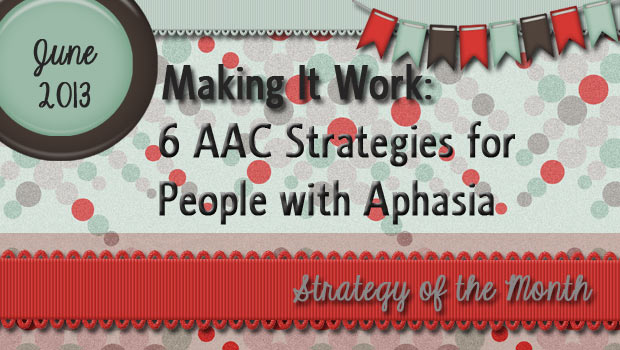
People with aphasia are often most successful when a number of different strategies are combined. In this post, we discuss a number of strategies that we can use in our therapy and teach to communication partners. Augmented Input We’ve written so many posts about aided language input that we’re almost embarrassed to bring it up again. Almost. It seems like no matter which age group or clinical population is the subject of our post, that strategy plays a central role. It is the same for people with aphasia with one exception. They benefit from a broader array of input cues, such as gestures, writing, and even pantomime. Augmented input is the term that is used to refer to oral language that is supplemented with pictures, print, gestures, pantomime, and the use of objects in the environment. By using these things as you speak, you enhance the ability of the person... [Read More...]
June 28, 2013
by Carole Zangari -
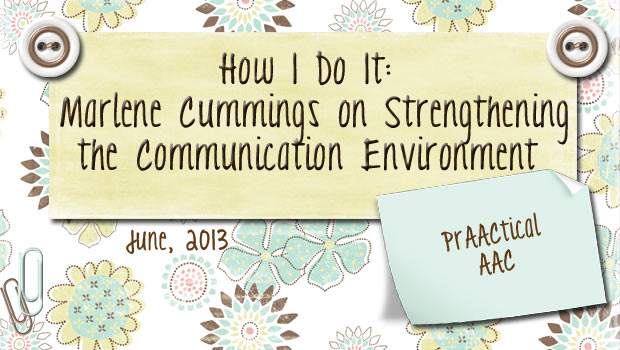
Marlene Cummings is back to share some thoughts on creating communication-friendly environments. As an AAC consultant to the Oakland Schools, Marlene gets to support AAC implementation in a variety of classrooms with all types of learners. You can read her earlier posts here and here. ::::::::::::::::::::::::::::::::::::::::::::::::::::::::::::::::::::::::::::::::::::::::::::::::::::::::::::::::::::::::::::::::::::::::::::::::::::::::: 5 Things to Consider in the “Communication Environment” The first thing we want to ask: Is language being represented visibly? We in AAC are often known by our “stuff”. Because we need to represent language visibly and love technology, we typically have a lot of “stuff”. I, for one, currently have a large storage unit holding 30+ years of “stuff” waiting to be distributed to all my new teams since I am no longer in the classroom. Let’s start by looking around our instructional environment. It is our intention to model the use of language being represented visibly and to provide the vocabulary and opportunities for... [Read More...]
June 26, 2013
by Carole Zangari -
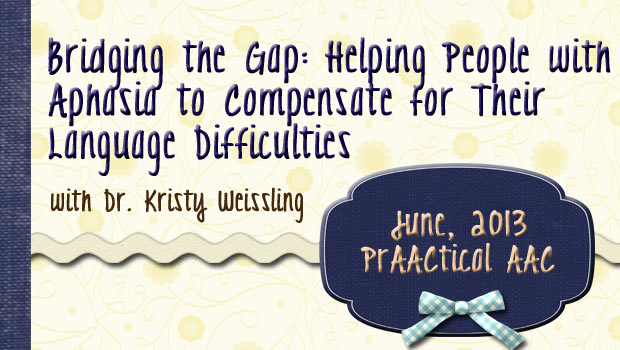
We’re wrapping up Aphasia Month with another fine post from Dr. Kristy Weissling. You can see her earlier posts here and here. In this post, Kristy shares her thoughts on how SLPs can use AAC supports to help individuals with aphasia compensate for their language difficulties. In 2010, my colleague, Carrie Prentice, and I talked about the role of both remediation and compensation in the speech rehabilitation programs of people with aphasia. At that time, we were trying to emphasize that at any particular time in the rehabilitation process, from acute care to outpatient rehabilitation, all possible alternatives should be balanced to create an individualized treatment program. Both restorative and compensatory mechanisms are available to therapist throughout this process. We proposed the work of Dixon, Garrett, and Backman (2008) to formulate a framework for discussing compensation. Six mechanisms of compensation were identified in their chapter on principles of compensation in... [Read More...]
June 22, 2013
by Robin Parker -
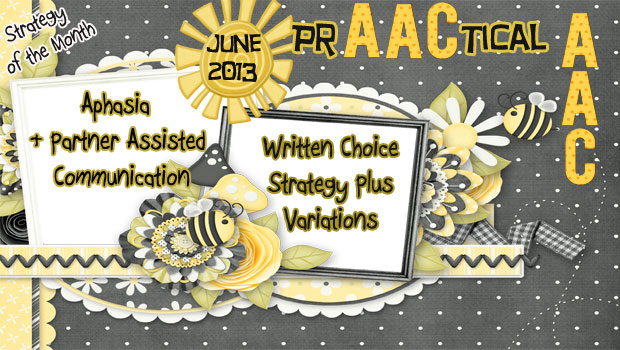
This month, we have enjoyed writing about communication strategies for aphasia. Partner supported communication is the platform for many of the effective techniques we use to help people with aphasia initiate, maintain, or terminate communication and conversation. We have talked about assessment strategies, communication books, and alphabet & topic supplementation. Now it is time to discuss the written choice strategy. The written choice strategy is fairly easy to implement, can look natural, and can result in seamless detailed conversation. Written choices are provided in the context of conversation and are displayed in an organized manner. What is It? The written choice strategy has the partner/facilitator generating written key-word choices that relate to the conversational topic. The written choices can be paired with text, pictures, drawings, symbols, and natural speech. The partner/facilitator writes possible answers to conversational questions in list form. The conversation is extended as continued written choices are offered... [Read More...]
June 21, 2013
by Carole Zangari -
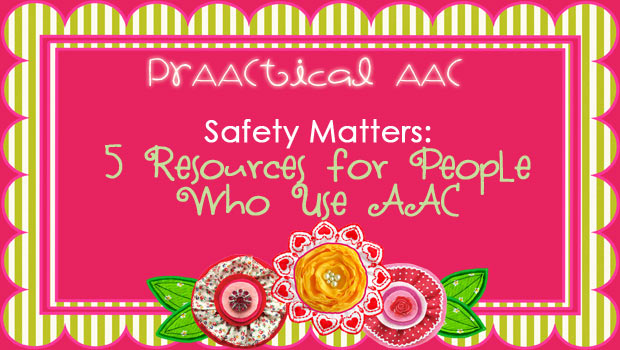
Though she was not the first of my clients with cerebral palsy who made me think long and hard about safety, Marla was the one who kept me up at night. It was the seventies, and I was a PCA when institutionalization was on the way out and community living was gaining ground. Marla lived on her own in an apartment and, for awhile when I was a college student, I visited her in the morning to get her up and at night to put her to bed. During the day, she could get around reasonably well and call for help if she needed it. But at night, after she was settled in bed, she was pretty much stuck there until someone returned in the morning. She didn’t have the physical skills to use a phone while lying down, and, if there was AT that would have helped, I... [Read More...]
June 17, 2013
by Carole Zangari -
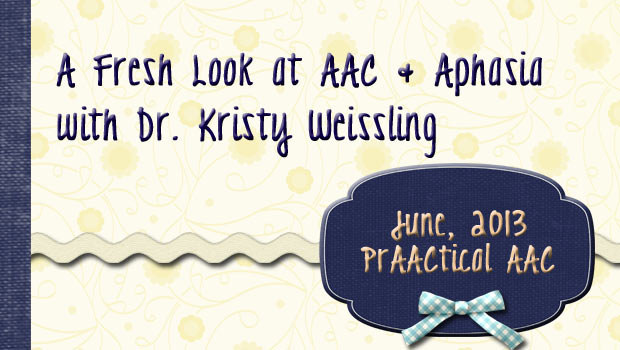
We’re so pleased to be able to share the thoughts of our friend and colleague, Dr. Kristy Weissling, on providing AAC supports to people with aphasia. She received her professional doctorate from Nova Southeastern University and is currently an Assistant Professor of Practice and clinical supervisor at the Barkley Speech-Language and Hearing Clinic at the University of Nebraska-Lincoln. Her research and teaching interests include, aphasia, cognitive communication impairments, and AAC. She participates in implementation of a portion of the RERC grant project at the University of Nebraska-Lincoln. She has been an instructor in aphasia and cognitive linguistic impairments for 15 years and teaches in both online and live formats. Her clinical load includes individual and group treatment of individuals with aphasia, traumatic brain injury, and early cognitive decline. In this post, Kristy reflects on three articles that have shaped her clinical services and teaching. :::::::::::::::::::::::::::::::::: I have been working with people who... [Read More...]
June 15, 2013
by Carole Zangari -
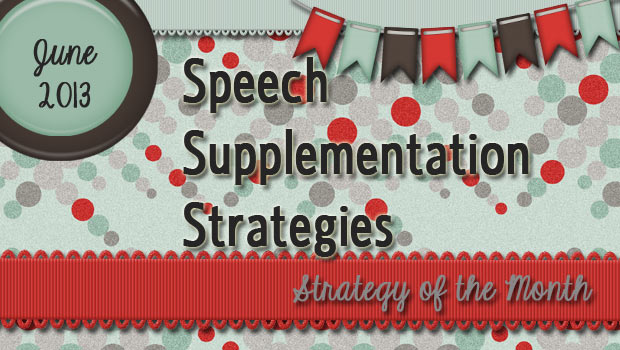
Anyone who has had a conversation with someone affected by aphasia is probably familiar with the ‘20 Questions’ approach to resolving communication breakdowns. Asking questions helps us take the piece of the message we understand (or think we do!) and build on that to gain more insight into the communicator’s intent. Take this exchange between a woman, Sandy, and her mother-in-law, Joan. Joan had a stroke a few years back and has both aphasia and dysarthria. Joan: “Gay” Sandy: “Gay? What do you mean, mom? Someone’s gay?” Joan: Shake head. “Gay” Sandy: “I’m not sure, mom. Gay?” Joan: “Gay” Points to the front door Sandy: “Kay? Are you telling me about Kay from across the street?” Joan: “Gay.” Nods Sandy: “What about Kay? Did she call?” Joan: Shakes head no Sandy: “Do I need to call her?” Joan: Shakes head no Sandy: “Did she stop by?” Joan: “Aaadihdih” Sandy: “Did... [Read More...]
June 13, 2013
by Carole Zangari -
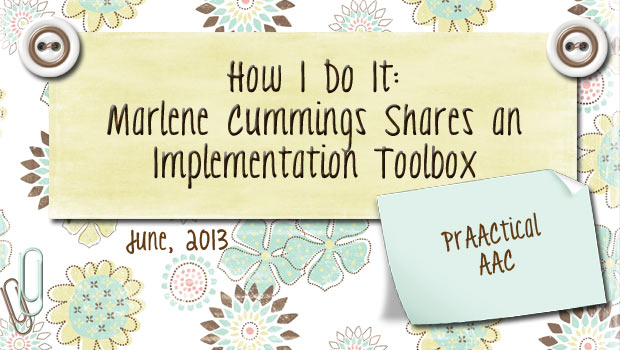
Now that the school year is winding down, some of you have a little more time to read, process, and prepare for next year. We are really excited to share more ideas from Marlene Cummings, one of the most experienced AAC SLPs that we know. Those of you who have been following Marlene’s posts on the AAC implementation will be pleased to see the next part of the Framework for Success that she developed with the AAC Team at Oakland School District. If you missed her first and second posts, go take a peek at them when you can. 5 Things in our “Implementation Toolbox” When we begin the process of implementing AAC it is important to consider our “thinking”. We always want to approach every student, every team and every classroom with as much wisdom and respect as possible. One of my colleagues, Dr. Penny Hatch, from UNC Chapel Hill... [Read More...]
May 30, 2013
by Carole Zangari -
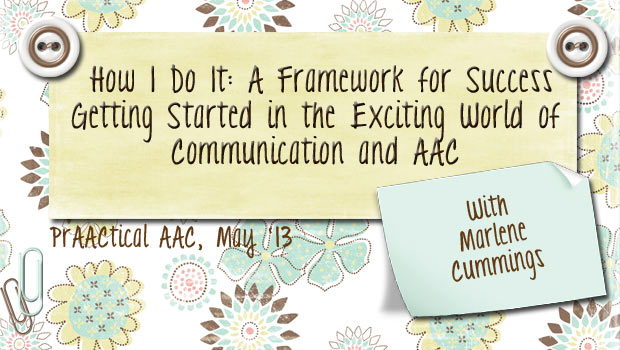
We couldn’t be more excited to have a return visit from Marlene Cummings, a wonderful SLP who is currently serving as an AAC Consultant to the AAC Team at Oakland Schools. In her first post, Marlene talked about strategies for cultivating the right mindset for AAC teaching. In this post, Marlene continues sharing elements of her Framework for Success in discussing the Knowledge Toolbox, developed with the Oakland Schools AAC Team. 5 Things in Your “Knowledge Toolbox” What is already in my “knowledge toolbox” of communication, language and learning? Yes, you do have a full toolbox. You just don’t realize it. And of course there are always new and exciting things to add. You already know this stuff!! REMEMBER??? It is important to step back and think broadly about communication and what it really does. Sometimes we get caught in the details of our work and can’t see the forest through the... [Read More...]
May 27, 2013
by Carole Zangari -
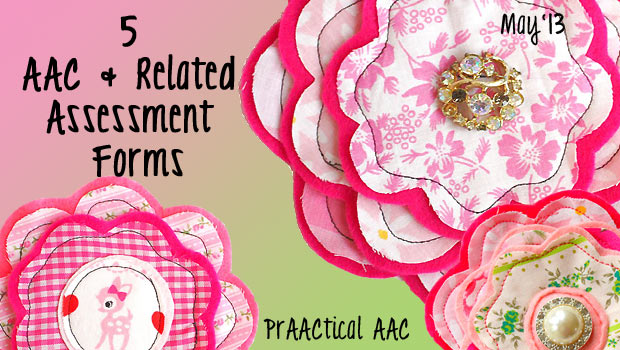
Ask any 10 professionals how they do AAC evaluations and you’re likely to get 10 different answers. We look for the same things (I think!) but go about it in different ways. We’re always happy to take a look at the protocols and forms that our colleagues develop and/or use. Here are some that might be of interest. 1. Bloom and Lahey Recording Sheet for staging language by Sherri Vernelso and Emily Pratt 2. Kate Ahern’s form for AAC device trials 3. SETT process assessment forms by HILIA Coordinators of Assistive Technology Services 4. The Functional Behavior Assessment Worksheet and Observation Forms by PaTTAN 5. Assessing the metaphoric use of pictures (e.g., Minspeak, Unity) protocol and forms by Gail Van Tatenhove If you have a protocol or form that you’d like to share, please get in touch. We’re always looking for new and better tools.









